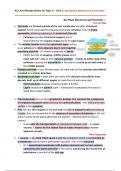Summary
Unit 2 Summary Edexcel International A Level Biology - Chapter 4
- Course
- Institution
- Book
Concise and coloured notes for Pearson Edexcel's International A Level Biology sat in January, June or October. This document follows the IAL specification and textbook order, covering all the topics in Unit 2, specifically Chapter 4: Development, Biodiversity & Conservation.
[Show more]





